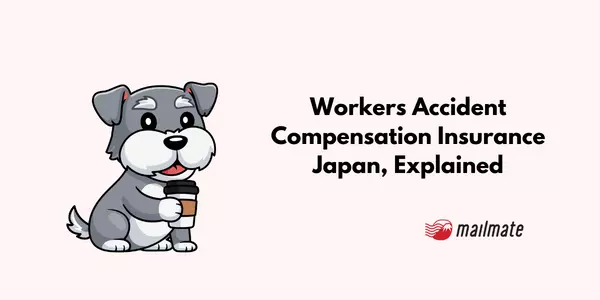Workers Accident Compensation Insurance Japan, Explained

For over a century, government support for work-related accidents has existed in Japan, insuring workers primarily in factory, mine, and construction industries.
However, in its early incarnation, these benefits were considerably lower than what other countries provided at the time. In September 1947, after WWII, a ground-breaking Labor Standards Law (Japanese PDF, MHLW) was enacted that improved standards for labor conditions, expanded coverage, and substantially raised compensation payouts.
Since then, workers' accident insurance in Japan has undergone a series of amendments, further expanding coverage and improving benefit levels.
Some of the more recent issues this system has been tackling over the past two decades include asbestos-related lung diseases, mental illness or injury or death from overwork, power harassment, and sexual harassment.
In this article, we look at all the essentials of Japan's Workers' Accident Compensation Insurance 労災保険 = rousai hoken: what it is, who it's for, how to enroll, and more.
A super-quick overview of what it is and how it works
Workers' accident insurance in Japan (労働 者 災害 補償 保険 = rōdōsha saigai hoshō hoken) is run by the government and covers expenses and compensations for work-related accidents, disability or death.
Any business that hires even one employee must enroll in workers' accident compensation insurance, and employers pay 100% of this insurance premium at the start of the fiscal year.
When a work-related accident occurs, employers are obligated to report to the Labor Standards Inspection Office. If expenses arise from a work-related accident, employees can file a request to the chief of Labor Standards Inspection Office for insurance benefits. (See this article for what to do in case of an accident involving an employee.)
Workers' accident insurance covers medical expenses, leave allowance, disability compensation, compensation for the bereaved family, and even support for the insured person's return to society. All other injuries and illnesses not related to work, such as childbirth, car accidents on vacation, etc., are covered by the national health insurance or employee's health insurance.
Employers are mandated by law (Labor Contract Act and Industrial Safety and Health Act) to make necessary safety precautions for a safe working environment.
Occasionally, there are unannounced inspections from the Labor Standards Inspection Office, so familiarize yourself with the relevant standards and regulations and enroll in workers' accident insurance if you are mandated to do so.
If you do not have safety measures in place for your employees, you may be held criminally liable whether there is an accident or not.
👉 Need an English-speaking personal injury lawyer or someone to help your business with legal affairs? Check out MailMate’s MailMate's bilingual lawyer directory.
Who must enroll, and who is eligible?
As mentioned in the previous section, if your business hires even one employee—regardless of their employment status, such as full-time, part-time, or day laborers—you must enroll in workers' accident compensation insurance.
However, some exceptions exist. The following types of businesses and employees are not covered by workers' accident compensation insurance, as other laws protect them.
Government office workers
Government-owned businesses
Those insured by seamen's insurance (other than those insured by voluntary disease continuation)
Also, contractors or board members with representative or administrative rights are not covered by workers' accident compensation insurance (although board members who work under a representative and receive wages can be covered).
Additionally, most freelancers are excluded from insurance coverage. Instead, a special voluntary enrollment system exists for freelancers who are excluded from the government's primary workers' accident insurance coverage. Some examples of sole proprietors/freelancers who can enroll in this voluntary insurance are taxi drivers, carpenters/construction workers, foresters, and fishers.
MHLW recently added animators, entertainment personalities (supporting roles for the entertainment industries included), and a Judo therapist/bone setter, effective from April 1, 2021.
The enrollment procedures for the special enrollment system must always be done through a proxy (the industries' respective unions or relevant agencies). You can find more details of eligibility requirements and the various application procedures here on the MHLW site.
How to enroll in workers' accident insurance
When enrolling in workers' accident insurance, the following documents must be submitted to the local Labor Standards Inspection Office:
Notice of Establishment of Labor Insurance Affiliation 保険関係成立届 = hokenkankei seiritsu todoke
Declaration of Estimated Labor Insurance Premiums 労働保険概算保険料申告書 roudouhoken gaisan hokenryou shinkokusho
Certificate of All Historical Matters 履歴事項全部証明書(写)a copy of rirekijikou zenbu shoumeisho
The submission deadline is within 10 days from the establishment date of the insurance relationship. Specifically speaking, the deadline for the document "Declaration of Estimated Labor Insurance Premiums" is 50 days. Still, it is generally recommended to submit it together with other documents and pay insurance premiums within 10 days.
How much does workers' compensation insurance cost?
You can calculate the workers' accident insurance premiums with the following formula: (total annual wage of all employees)* x (insurance premium rate)** = workers' accident insurance premiums.
*The total employee wages are calculated by totaling the monthly wages and bonuses paid each month.
**You can find a list of insurance premium rates by industries posted here (Japanese PDF) on the MHLW site. The rates have not changed since 2018.
Insurance rates differ by industry because certain businesses are more prone to work-related accidents than others.
If you are a 継続事業 = keizokujigyou "continuing business," you will pay the year's estimate of the workers' accident insurance premiums beforehand, with the difference settled at the end of the fiscal year.
If employees are hired or retire in the middle of a fiscal year, you file a report within 50 days of the event. And, if applicable, the difference will be refunded to you.
Premium rates are reevaluated every 3 years for establishments with 100 or more employees, according to the number of reported work-related accidents (merit system). If your business applies to this system, the labor bureau will notify you when a change has been made to the premium rates, so you do not need to make an application.
You can find forms for filing and paying insurance premiums here on the Labor Insurance Information Center site.
While calculating these premiums is done via self-evaluation, the MHLW site provides excel file templates to help with your calculations.
Many software solutions assist companies with these calculations, and accounting firms can help with this payroll task.
Final thoughts
In a nutshell, workers' accident insurance in Japan is insurance paid by employers and not by employees. The purpose of this insurance is to protect the health and livelihood of employees, as well as dispatched workers and part-timers, too.
Also, keep in mind the term "labor insurance" in Japan typically refers to both unemployment insurance (covered previously) and workers' accident insurance (covered in this article).
For most cases, companies enrolling in unemployment insurance are also enrolled in workers' accident insurance, and they pay both premiums together.
Note: This article and the previous articles in this series, "Employees' Pension Insurance in Japan," "Employees' Health Insurance in Japan," and "Unemployment Insurance in Japan" are intended to provide you with general information only.
Spending too long figuring out your Japanese mail?
Virtual mail + translation services start at 3800 per month. 30-day money-back guarantee.

